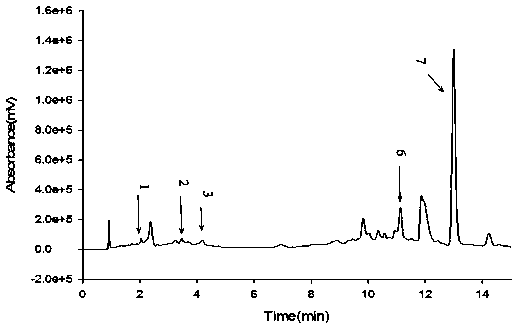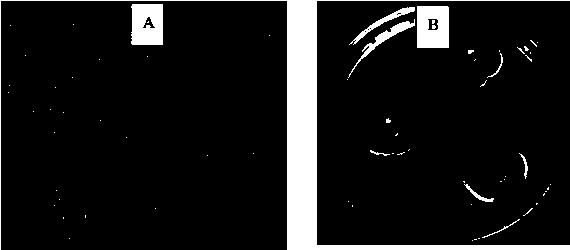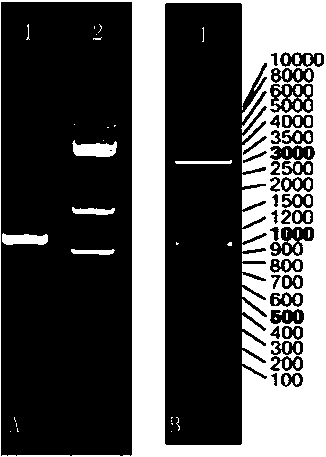A fungus with strong herbicidal effect screened from passion fruit rhizosphere soil
A rhizosphere soil and anti-grass fungus technology, applied in the direction of fungi, application, herbicides and algicides, etc., can solve the problems of soil and groundwater pollution, increase the residue of harmful substances, etc., and achieve good environmental compatibility and environmental protection. safe effect
- Summary
- Abstract
- Description
- Claims
- Application Information
AI Technical Summary
Problems solved by technology
Method used
Image
Examples
Embodiment 1
[0022] Biological test of the herb-inhibiting ability of the fermentation broth of the strain
[0023] Put a piece of filter paper in the tissue culture bottle respectively, take 5 mL of the fermented liquid diluted 50 times and add it to the tissue culture bottle, sow 5 pieces of lettuce that has just turned white in each tissue culture bottle, and distilled water as a control, and put them They were cultured in a constant temperature incubator at 28°C, and each experiment was repeated three times. The root length and plant height of lettuce were measured after 3 days of cultivation. The inhibition rate is calculated according to the formula: IR = (1- TR / CK ) × 100%. in, IR : Inhibition rate (Inhibition rate); TR : Treatment (Treatment); CK : Control.
[0024] Then we took barnyardgrass and wolf's tail grass as the experimental objects to test the ability of the fermentation broth to inhibit weeds. With barnyardgrass as the experimental object, the fermentation l...
Embodiment 2
[0028] Example 2 strain identification
[0029] 1. Morphological identification
[0030] Morphological observation of colonies
[0031] In the middle of the PDA solid medium plate, the fungus cake punched with a hole puncher with a diameter of 0.8 cm was inserted, continuously cultured at 28°C for 7 days, and the morphological characteristics such as texture and color pattern of the edge and surface of the colony were observed every day.
[0032] Microscopic Morphological Observation
[0033] Use a dissecting needle to pick out a little colony from the colony cultured on the PDA solid medium plate for 3 days, put it on a glass slide dripped with sterile water in the middle, then use two dissecting needles to disperse the colony as much as possible, and cover it with a cover glass Blot the water around the slide with absorbent paper, and observe the conidiophores and spores under an optical microscope.
[0034] The morphological identification was based on the characteristic...
Embodiment 3
[0043] Example 3 Determination of Phenolic Acids in Strain Fermentation Broth
[0044] Take 100 mL of fermentation broth, adjust the pH to 4.00 with phosphoric acid, then add 8 g of NaCl, and dissolve the solution for use. Take the Cleanert PEP solid phase extraction column and activate it by soaking and rinsing with distilled water-methanol-distilled water (8 mL - 8 mL - 6 mL) respectively, and then remove the residual methanol for later use. Add the treated fermentation broth to the activated PEP solid-phase extraction column. When the fermentation broth has run out, add 2mL of distilled water to rinse, then add 10mL of methanol to elute, and collect the eluate and freeze-dry it. . After dissolving with 1mL of methanol (chromatographically pure), use a 0.22μmL filter membrane to filter into the sample bottle, which is the sample of the fermentation broth.
[0045] Seven phenolic acids including protocatechuic acid, ferulic acid, cinnamic acid, vanillic acid, salicylic acid...
PUM
 Login to View More
Login to View More Abstract
Description
Claims
Application Information
 Login to View More
Login to View More - R&D
- Intellectual Property
- Life Sciences
- Materials
- Tech Scout
- Unparalleled Data Quality
- Higher Quality Content
- 60% Fewer Hallucinations
Browse by: Latest US Patents, China's latest patents, Technical Efficacy Thesaurus, Application Domain, Technology Topic, Popular Technical Reports.
© 2025 PatSnap. All rights reserved.Legal|Privacy policy|Modern Slavery Act Transparency Statement|Sitemap|About US| Contact US: help@patsnap.com



